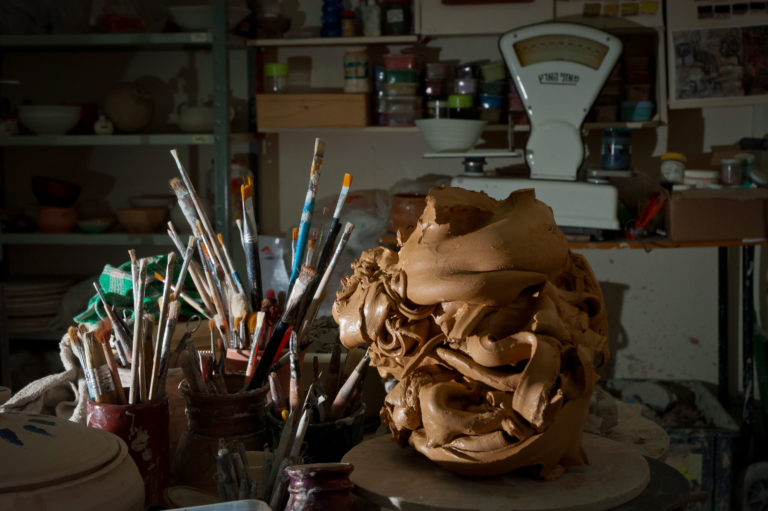
Image by Flavio Grynszpan.
Cherishing the Confusion and the Mess
Four semesters of ceramics classes — hand-building and the wheel — have taught me the joy of making things, however imperfect, that you can actually use or give to friends: spoon rests, mugs, bowls, and candlesticks. It’s taught me the childlike pleasure of getting dirty: my glasses splattered, my hands caked with dry clay, my soiled clothes pitched into the washing machine the second I walk in the door.
It’s taught me that when I’m out-of-sorts, un-centered, it’s impossible to center a pot on the spinning wheel, as if my emotional state were contagious. It’s taught me that four identical cups, dipped in turquoise glaze, can produce three that are the intended blue and one that’s mottled brown and gold, depending on where they’re positioned in the 2,200-degree-Fahrenheit kiln, or whether they were fired at the same time.
Now my ceramics education has, in a manner of speaking, begun anew. As a summertime treat at the 92nd Street Y in New York City, stoneware is replaced by porcelain for a few months each year. This new white clay feels completely different in my hands from the previous red clay, performs in unexpected ways, and requires new glazing techniques. A lot that I’ve learned still applies, and I’m surely more adept than I was months ago, but in many ways, I’m starting from scratch.
As with life itself, it’s a juncture both thrilling and unnerving.
Stoneware is stiffer and grittier, made from a recipe that includes grog, pre-fired clay that is ground up afterward and mixed in. Porcelain is silky smooth and lighter in your hands. It is more porous than stoneware and gets sloppy very quickly when a wet sponge is used to smooth cracks or a watery mixture is used to score and slip, the technique for attaching one piece of clay to another, say a handle to a cup or a foot to the base of a bowl.

It also shrinks more in the kiln, first during the bisque firing and again during the glaze firing, so the original piece is at least a third smaller at the end of the process than at the beginning. In the case of a coffee mug, that shrinkage must be taken into account or your finger won’t fit in the handle. In the case of beads meant for stringing, the hole must be large enough not to disappear before the insertion of a leather thong or ribbon.
And certain glazes, like the glossy white I applied to some beads, leave but a thin coating on the porcelain, which has a lovely translucent quality. Other glazes, like the copper red on a small wine cup, are thick and dense in a way they aren’t on stoneware, obscuring a pattern (like lace pressed into the wet clay or pinholes made with a tool) that is intended to remain visible. I have eight more beads and two more cups that will be glazed next week. My intention is to replicate the first set of beads but try different glazes on the cups, probably old yellow and saunders celadon, which on the sample tiles in the studio appear thinner than the copper red and may expose the pattern.
The buckets of glaze, by the way, provide little information about their thickness and color once fired. All are the same consistency if they are thoroughly mixing with a toilet plunger or huge whisk; unmixed, they are thin on the top and goopy at the bottom. And the color of the glaze in the bucket bears no relationship to how it will look later. Old yellow, for instance, is pink in the bucket, not pale lemon; and saunders celadon murky brown rather than artichoke green.
There must be accomplished ceramic artists who master these apparently inherent inconsistencies, who make things that reliably are the size, shape, and color they intended. Maybe they mix their own clay from feldspar and bone ash and grog and its other many ingredients. Maybe they own kilns, rather than share the three electric and one gas-reduction kilns at the Y — with temperatures that never vary. Surely they load the kilns themselves, and know how to position their pieces, whereas the kilns at the Y are filled by whatever assistant is on duty when one is empty and there are enough pieces waiting to fill it.
Maybe someday I’ll be accomplished and determined enough to have those private resources. But for now, unlike some of my more precise fellow students, I cherish the confusion of not knowing what’s going to come out of the kiln. My house is orderly, my books alphabetized. There’s a place for everything and everything is in its place. In the studio, I’m not only learning to make pots, I’m learning to make a mess. Maybe that’s worth more than becoming a gifted potter.


